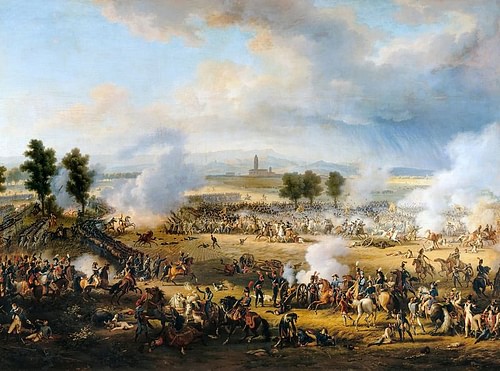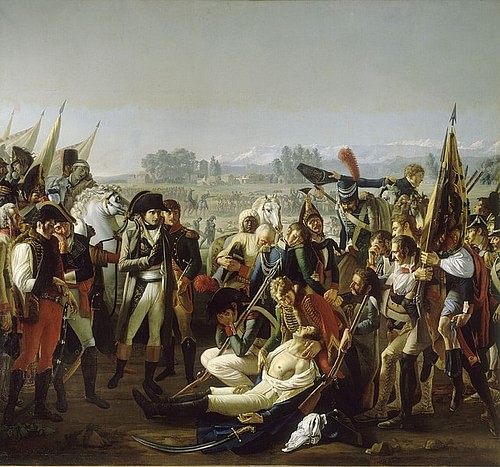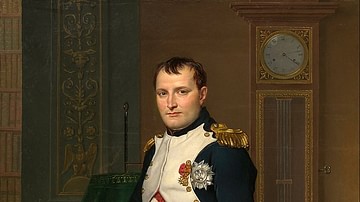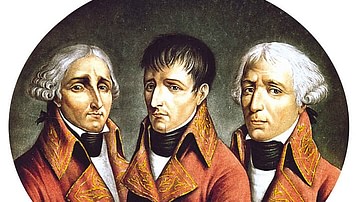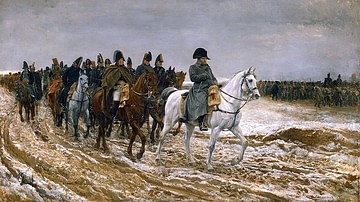The Battle of Marengo (14 June 1800) was one of the most important battles in the career of Napoleon Bonaparte (1769-1821). It not only helped bring the French Revolutionary Wars to an end but also did much to consolidate Bonaparte's new position as First Consul of the French Republic. The battle became a major piece of propaganda for the Bonapartist regime.
Background
In the months after he seized power in the Coup of 18 Brumaire, First Consul Napoleon Bonaparte was far from secure in his new position. He was still considered by many to be an up-jumped Corsican opportunist, and he had no shortage of rivals – such as generals Jean Bernadotte and Jean Victor Moreau – who would be glad to see his fall from grace. Further, the French Republic was still embroiled in the unpopular War of the Second Coalition (1798-1802) against an alliance of anti-French powers including Austria, Russia, Britain, the Ottoman Empire, and Naples. This conflict was part of the broader French Revolutionary Wars (1792-1802), meaning that by January 1800, France had been perpetually at war for the better part of a decade. With much of the general populace war-weary, Bonaparte knew he had to deliver a swift, decisive victory if he wanted to win the support of his people.
His first step was to order the formation of a 30,000-man army based at Dijon, primarily consisting of soldiers who had been on garrison duty in the provinces. Though Bonaparte fully intended to lead this army over the Alps to fight the Austrians in northern Italy, its true purpose had to be concealed; it was named the Army of the Reserve and was placed under the command of Bonaparte's trusted chief of staff Louis-Alexandre Berthier.
While onlookers believed the ruse that this was merely a reserve force, Bonaparte secretly prepared the army for campaigning. Soldiers were trained using the 'canteen' system, whereby eight veterans and eight recruits would march, eat, and camp together, fostering a sense of camaraderie and allowing the recruits to learn quicker. Meanwhile, Bonaparte worked with war minister Lazare Carnot to procure 100,000 pairs of boots, 40,000 uniforms, and 2 million rations of biscuits for the army at Dijon. The First Consul also ordered all major field forces to adopt the corps d'armée system, breaking each army down into mobile and semi-independent corps; this would become a staple of Napoleonic warfare.
As his army was being prepared, Bonaparte poured over maps to decide where he would cross the Alps. He decided to take the main part of his army across the 2469-meter (8,100-foot) Great St Bernard Pass, while a division under General Adrien Moncey would take the St Gothard Pass. During one strategy meeting, Bonaparte purportedly asked his secretary, Bourrienne, where he thought the decisive battle would be fought once the French had gotten over the Alps. "How the devil should I know?" asked Bourrienne, as the First Consul drove a pin into a map on the plains of the Scrivia River. "I shall fight him here," said Bonaparte. It was the exact spot where he would fight the Battle of Marengo three months later, a demonstration of Bonaparte's quick and perceptive mind (Roberts, 252; Chandler, 275).
Siege of Genoa
In 1799, Coalition forces had conquered most of northern Italy, undoing almost all the gains made by Napoleon's Italian Campaign of 1796-97. This had primarily been the work of Russian General Alexander Suvorov, who had never lost a battle but had since been recalled to St Petersburg; command of the Allied forces in Italy now fell to Austrian General Michael von Melas, who had around 97,000 men at his disposal at the opening of the 1800 campaign season. Determined to finish what Suvorov had started, Melas planned to capture Genoa before pushing on into France itself and laying siege to the valuable port city of Toulon.
On 5 April, Melas launched his offensive much earlier than expected, catching French General André Masséna and his overextended Army of Italy completely by surprise. Within days, Masséna was forced into Genoa with only 12,000 men, where he soon found himself under siege by 24,000 Austrians under General Karl von Ott and blockaded by the Royal Navy from the sea. Conditions in Genoa quickly deteriorated, as soldiers and civilians alike were reduced to eating cats, dogs, and even rats. Thousands died of malnutrition, yet for weeks, Masséna refused to surrender; he ordered his men to shoot Genoans who assembled in groups larger than four, for fear that they would try to open the gates to the enemy.
Napoleon Crosses the Alps
Realizing that France was in danger of invasion should Genoa fall, Bonaparte knew the time had come to act. General Moreau, in charge of the Army of the Rhine, began an offensive against the Austrians in Germany on 25 April while the Army of the Reserve was quietly moved to Geneva, Switzerland. Bonaparte himself lingered in Paris to finish overseeing preparations; he even held a public inspection of his worst-equipped troops to throw off any Austrian spies.
Finally, after attending the opera on the night of 5 May, Bonaparte slipped out of the capital and arrived in Geneva at 3 a.m. on the 9th. Sending orders to Masséna to hold out as long as possible, Bonaparte prepared his army for the crossing, giving each soldier nine days' rations and 40 cartridges. Early on the morning of 15 May, the French vanguard under General François Watrin began to ascend the Great St Bernard Pass, followed closely by the corps of generals Jean Lannes, Claude Victor-Perrin, and Philibert Duhesme. Bonaparte followed last, riding a mule, accompanied by his elite Consular Guard.

Though plenty of armies had crossed over the Alps since the days of Hannibal Barca, no modern army had attempted to cross such a high pass so early in the year, encumbered with a full train of artillery and supplies. The route was covered in heaps of snow and ice and was fraught with "steep paths, narrow gorges, and threatening glaciers" (Chandler, 276). The soldiers had to march in single file in some of the narrower places and had to start at dawn every day to reduce the risk of avalanches. At the village of St Pierre, the route became impassable for the heavy-wheeled artillery. Cannons were placed in hollowed-out tree trunks and harnessed to groups of 100 men, while carriages were taken apart and carried by sections. When the soldiers reached the top of the pass, they stopped to rest at the famous Hospice of St. Bernard, where they were given wine, bread, and cheese by the resident monks. Despite some difficulties, the crossing took only eleven days and the weather remained relatively decent.
When the French reached the entrance to the Aosta Valley, they were held up by Fort Bard, garrisoned by 400 Hungarian soldiers under Captain Joseph Bernkopf. It took Fort Bard twelve days to fall, delaying the French army's entrance into Italy and using up much-needed ammunition. Still, Bonaparte had completed his cross over the Alps at a relatively low cost. "We have fallen like a thunder bolt," he wrote to his brother Joseph, "the enemy did not expect us and still seem scarcely to believe it" (Chandler, 281).
Prelude to Marengo
At this stage, having gathered his army at Ivrea, everyone expected Bonaparte to rush to the aid of Masséna and relieve the siege of Genoa. Instead, he turned eastwards towards the undefended city of Milan; unwilling to offer Melas battle quite yet, Bonaparte sought instead to seize Milan's supply depot and cut off Melas' retreat toward the Mincio River. At 6:30 p.m. on 2 June, Bonaparte entered Milan and set himself up in the archducal palace, where he held court until 2 a.m.
Melas panicked and ordered General Ott to end the siege of Genoa so he could concentrate his forces. Ott refused, since Masséna has just asked for terms of surrender. Having held out for as long as possible, Genoa had reached the end of its rope; 30,000 of its original 140,000 inhabitants had died alongside 4,000 French soldiers (Roberts, 257). On 4 June, Ott allowed the French to surrender with the honors of war. Upon hearing the news, Bonaparte frustratedly wondered why Masséna could not have held out a few days longer, while Masséna never fully forgave Bonaparte for abandoning him in Genoa.
Though the French had lost Genoa, Bonaparte was still in a good position; the capture of Milan had put him behind Melas' army, and Bonaparte positioned his divisions on each of Melas' potential routes of escape. On 9 June, General Lannes won a victory over General Ott at the Battle of Montebello, which forced Ott to retreat across the Scrivia to Alessandria, where he linked back up with Melas. The Army of the Reserve closed in, with the First Consul and 28,000 of his men arriving at Stradella on 11 June amidst pouring rain; Bonaparte wrote to his wife Joséphine de Beauharnais complaining that he had "a wretched cold". That same day, the French were joined by General Louis Desaix, one of the most capable commanders of Napoleon's Campaign in Egypt and Syria who had only just returned from Egypt. Desaix was immediately given command of a corps.
At this point, Bonaparte was under the false assumption that the Austrians were preparing to retreat north, a belief encouraged by the double agent Francesco Tolli. In fact, Melas was prepared to make a stand. Lacking this information, and overconfident from the victory at Montebello, Bonaparte's main concern was stopping the Austrians from escaping; to this end, he ordered Desaix to lead a division south to Novi Ligure to prevent the Austrians from retreating along the Genoa-Alessandria highway.
Meanwhile, he sent 3,000 men under General La Poype north of the Po to guard the crossings there. Generals Victor and Gardanne were sent to capture the village of Marengo, about 3.2 km (2 mi) east of Alessandria, which they did on 13 June after clearing out 4,000 Austrian defenders. Bonaparte was, by now, uneasy; he had not received accurate word of enemy troop movements for four days. Yet, thanks to a series of misleading reports, the First Consul remained convinced that the Austrians were trying to escape. He was, therefore, unprepared for the Austrian counterattack that came the next morning.
Battle of Marengo
When the sun began to rise at 4:30 a.m. on Saturday, 14 June 1800, it was already clear that it would be a blisteringly hot day. Only 15,000 French soldiers, mostly from Victor's corps, slept on the fields of Marengo; Bonaparte and his Consular Guard had spent the night at Torre Garofoli, 5 km (3 mi) away. The white-coated Austrians, almost 31,000 strong, slowly moved into position, crossing over the Bormida River in floating bridges they had built the night before. By 9 a.m., the Austrians drove back the French pickets and began bombarding the French positions with 92 cannons. A column of 18,000 Austrians led by Melas descended on Marengo itself while another column of 7,500 men, under Ott, veered left toward Castel Ceriolo, where the Austrians falsely believed a large French force was stationed.
The surprised French rushed to take positions, and General Gardanne managed to get his six battalions lined up behind the Fontanone stream, in front of the town of Marengo. Sustaining heavy casualties from the Austrian artillery, Gardanne's line held against the first Austrian charge that consisted of General Hadik's division; the Austrians were forced into a funnel by bad ground and the stream, causing them to retreat after Hadik was killed. At 10 a.m., General Lannes arrived with reinforcements, just in time to help fend off a second Austrian charge led by General Kain's division. The firefight along the Fontanone stream lasted for two grueling hours in the summer heat; it got so hot that soldiers were reduced to urinating on their muskets to prevent them from overheating.

Bonaparte arrived on the field at 11 a.m. and immediately realized the direness of the situation; Ott's corps still threatened to fall on the exposed French right flank, while Victor's and Lannes' men were running low on ammunition. Bonaparte sent messages to Desaix and La Poype, urging them to return to Marengo. "It was my plan to attack Melas, but he has attacked me first," Bonaparte wrote to Desaix. "For God's sake, come back if you still can" (Blanning, 223). La Poype was too far away and would not receive the message until the battle was over, but Desaix had been held up by a swollen river and was still only 20 km (12 mi) southeast of the battlefield. Upon receiving Bonaparte's message, Desaix wheeled around and rushed toward Marengo, hoping he would arrive in time.
Desaix Arrives
Between noon and 1 p.m., a lull descended on the battle as both sides regrouped. Victor's corps was exhausted and depleted from sustaining the brunt of the enemy attack. Rather than reinforce Victor, Bonaparte ordered his reserves, including his Consular Guard, to attack Castel Ceriolo to keep General Ott's Austrian column occupied. The French attack on Castel Ceriolo began at 2 p.m., the same time that the Austrians launched another assault on the Fontanone stream. This time, Victor's corps could not withstand the pressure, and the French were sent running back toward San Giuliano, leaving Marengo itself in the hands of the Austrians.
At this point, it appeared that the battle was as good as over. Melas, who had had two horses shot out from under him and had sustained a wound to his forearm, decided to return to Alessandria. He left his chief of staff, General Anton von Zach, in charge of mopping up the remaining French resistance. There was another pause in the fighting as Zach formed his men into a massive pursuit column while, near San Giuliano, Victor was desperately reforming his men. On the right, the Austrians finally captured French General Achille Dampierre, whose small force of 300 men had hidden in ditches and ravines to fire shots at the Austrians all day. The Consular Guard had barely withstood a cavalry charge, suffering 260 killed. Indeed, it looked bleak for the French.
It was at this moment, around 3 p.m., that General Desaix finally arrived, meeting with Bonaparte just outside San Giuliano. "Well, what do you think of it?" Bonaparte asked Desaix, who apparently replied, "Well, this battle is completely lost, but it is only two o'clock. There is time to win another" (Chandler, 293). After a brief war council, General Auguste de Marmont gathered all available divisional cannons and unleashed a 20-minute bombardment on the enemy artillery. This proved very effective, damaging many Austrian guns and tearing holes in Zach's concentrated column of troops. Out of the smoke came Desaix's 6,000 fresh troops charging directly toward the shaken Austrian lines; almost immediately, Desaix was struck by a bullet, having only the opportunity to utter one word – "Mort" – before sliding off his saddle, dead.
As Desaix's men engaged the Austrians, General François-Étienne de Kellermann, commander of the French cavalry, saw an opportunity. On his own initiative, he charged directly into the left flank of Zach's column; alongside Desaix's timely arrival, Kellermann's charge turned the Austrian victory into a defeat. The panicked Austrian soldiers began to run back toward the Bormida and General Zach was captured along with thousands of his men. The hard-fought Battle of Marengo was over; Bonaparte had won, but only by the skin of his teeth. The Austrians had not been decisively defeated as he had hoped and he had lost Desaix, one of his most competent generals. "Why am I not allowed to weep?" Bonaparte asked when he heard the news of Desaix's death. Though Bonaparte's propagandists would later claim that Desaix's last words had been, "Go and tell the First Consul that I die regretting not to have done enough to live on in the memory of posterity," this is certainly untrue, as Desaix died almost instantly.
Aftermath
The Battle of Marengo was costly to both sides: of the 28,000 French soldiers, 5,000 became casualties, while the Austrians lost around 6,000 dead and wounded, 8,000 prisoners, and 40 guns captured. The night of the battle, Melas asked for an armistice, and Bonaparte allowed him to retreat east of the Trincio River, provided the Austrians surrender all fortresses in Piedmont and Lombardy. With the Italian campaign over, Bonaparte dissolved the Army of the Reserve on 23 June; its units were incorporated into the Army of Italy.
The Battle of Marengo did not give Bonaparte the total victory he desired, nor did it knock Austria out of the war; indeed, the Austrians would continue fighting for another half-year, until their defeat by Moreau at the Battle of Hohenlinden (3 December 1800). Yet it was Bonaparte's first major victory as head of state and, as such, greatly helped to consolidate his position as First Consul and secure the legitimacy of the new regime. Moreover, the battle soon became fodder for Bonaparte's propagandists and would play a central role in the growing Napoleonic legend. The story of the battle was rewritten three times during Napoleon's rule, with the First Consul's own participation exaggerated in the retellings. The political ramifications of Marengo led French historian François Furet to quote a royalist agent's claim that "Marengo was the baptism of Napoleon's personal power" (Blanning, 226).

